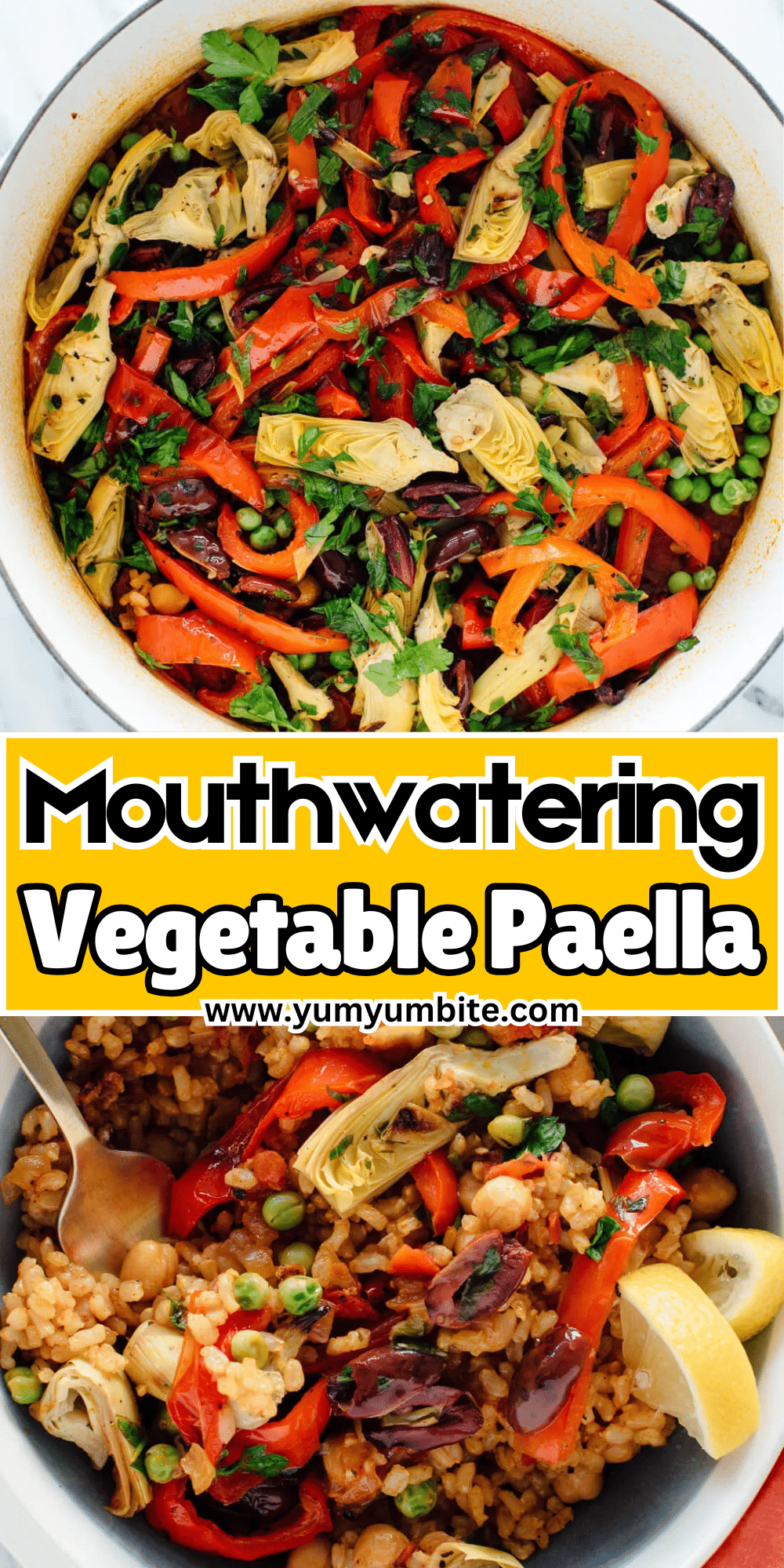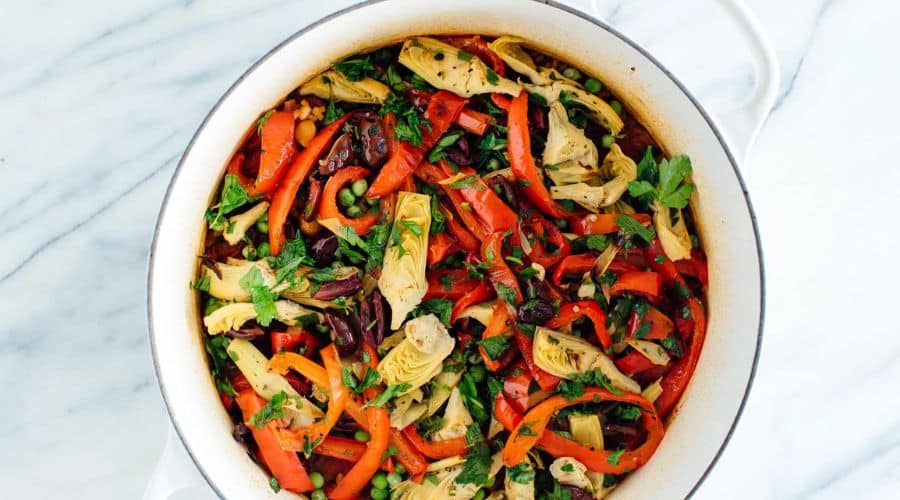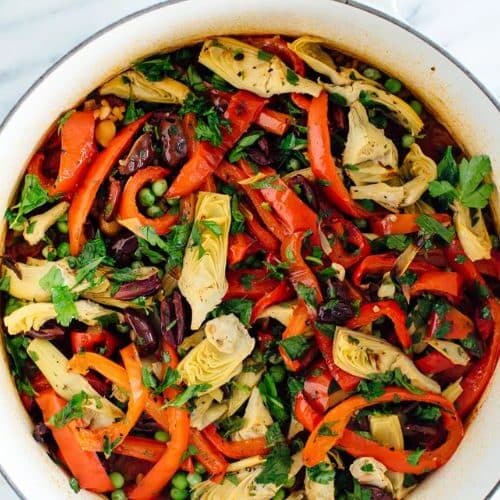All products are selected by our editorial team for quality. If you buy through our links, we may earn a small commission at no extra cost to you.
Vegetable Paella is a colorful and aromatic dish that celebrates the richness of fresh vegetables and the essence of Spanish cuisine.
Traditionally, paella is a rice-based dish originating from the region of Valencia, Spain, known for its vibrant flavors and beautiful presentation.
The vegetable version offers a hearty, yet light alternative to the classic meat or seafood options, making it a perfect choice for vegetarians and those seeking a wholesome meal.
Packed with seasonal vegetables, fragrant saffron, and a blend of savory spices, Vegetable Paella is not only a treat for the taste buds but also a feast for the eyes.
Whether enjoyed on its own or paired with a side salad or crusty bread, this dish is both satisfying and nutritious.
Best of all, it’s easy to prepare, making it ideal for family gatherings or weeknight dinners.
The delightful combination of tender vegetables and perfectly cooked rice makes Vegetable Paella a dish that everyone will love.

What is Vegetable Paella?
Vegetable Paella is a variation of the traditional Spanish paella that replaces the usual meat or seafood with an assortment of vibrant, seasonal vegetables.
Just like its meaty counterparts, Vegetable Paella features the signature rice, saffron, and spices that give it its distinct flavor.
The base of the dish is made by sautéing vegetables and then simmering rice with vegetable broth, creating a rich, flavorful meal.
While paella originated in the coastal regions of Spain, particularly in Valencia, the dish has been adapted over time to suit various tastes and dietary preferences.
Vegetable Paella is a celebration of the season’s finest produce, often including ingredients like bell peppers, tomatoes, peas, artichokes, and green beans.
It’s a versatile dish, meaning you can add or substitute vegetables based on what’s in season or available at the market.
The beauty of Vegetable Paella lies in its simplicity—each ingredient shines through in the final dish, creating a harmony of flavors.
Though the classic paella often features a mix of seafood, chicken, and rabbit, the vegetable version offers a lighter, yet equally delicious alternative that doesn’t compromise on taste.
Paella’s unmistakable aroma, combined with the tender texture of the rice and the sweetness of the vegetables, makes it an unforgettable meal.
Key Ingredients for Vegetable Paella
Rice
The heart of every paella is the rice, and for the best results, you’ll want to use short-grain rice, such as Bomba rice.
This type of rice absorbs liquid beautifully while maintaining a tender texture without becoming mushy.
Bomba rice also helps create the signature socarrat—the crispy, caramelized layer at the bottom of the pan that adds a delightful crunch to the dish.
Vegetables
A key component of Vegetable Paella is, of course, the vegetables.
Bell peppers, tomatoes, peas, and artichokes are common ingredients in a classic vegetable paella.
You can also include seasonal vegetables like zucchini, green beans, or even roasted mushrooms for added flavor and texture.
The beauty of Vegetable Paella lies in its versatility—you can adjust the vegetables depending on what’s available in your pantry or local market.
Saffron & Spices
Saffron is the essential spice that gives paella its signature golden color and unique flavor.
It’s worth the investment, as a small pinch of saffron threads goes a long way.
If saffron is hard to find or too expensive, you can substitute it with turmeric for color, though it won’t replicate the delicate flavor entirely.
Paprika, particularly smoked paprika, adds depth and a mild smokiness to the dish, balancing the richness of the vegetables and rice.
Broth
Vegetable broth is used to infuse the rice with flavor as it simmers.
The broth enhances the dish’s savory base, making every bite a comforting, hearty experience.
It’s important to use a flavorful broth—homemade or store-bought—that complements the fresh vegetables and spices.
Olive Oil
Olive oil is essential in paella for sautéing the vegetables and helping to toast the rice.
It imparts a rich, fruity flavor that ties all the ingredients together.
Using extra-virgin olive oil is highly recommended for its quality and taste.
Preparing Vegetable Paella: Step-by-Step Instructions

Step 1: Sautéing the Vegetables
Begin by heating olive oil in a large pan or paella pan over medium heat.
Add chopped onions and minced garlic to the pan and sauté for about 2-3 minutes, or until fragrant and softened.
Next, add your bell peppers and cook for an additional 5 minutes, stirring occasionally.
Then, incorporate your other vegetables—such as peas, artichokes, and green beans—and cook them for 5-7 minutes until they’re tender and lightly browned.
Step 2: Toasting the Rice
Once the vegetables are softened, add the rice to the pan.
Stir the rice into the vegetables, allowing it to lightly toast for about 2 minutes.
This step enhances the flavor of the rice, giving it a nutty aroma.
Make sure the rice is evenly coated with olive oil and vegetable juices, so each grain is well-seasoned.
Step 3: Adding the Broth & Seasoning
Now it’s time to add the vegetable broth. Pour in the broth along with a pinch of saffron (or turmeric, if you prefer), paprika, salt, and pepper.
Stir everything together and bring the mixture to a gentle simmer.
Allow the broth to simmer for about 10 minutes so that the rice absorbs the flavors and begins to cook through.
Step 4: Simmering the Paella
Once the broth is added, reduce the heat and let the paella simmer, uncovered, for about 20-25 minutes.
Avoid stirring the rice after this point, as paella is traditionally cooked without stirring to create the socarrat.
Keep an eye on the liquid level—if it starts to evaporate too quickly, add a little more broth or water.
Allow the rice to absorb the liquid completely and become tender.
Step 5: Letting the Paella Rest
Once the rice has absorbed all the liquid, remove the pan from the heat. Cover the paella with a clean kitchen towel or lid and let it rest for 5-10 minutes.
This allows the flavors to fully meld together and gives the rice a chance to firm up slightly.
Tips for Perfecting Your Vegetable Paella
Use the Right Pan
For the best results, use a wide, shallow pan, ideally a paella pan.
The shape and size of the pan allow the rice to cook evenly and helps to form the crispy socarrat layer on the bottom.
If you don’t have a paella pan, any large, flat skillet will work.
Avoid Stirring After Adding the Broth
Once the broth has been added and the rice begins to cook, resist the urge to stir.
Stirring can release excess starch, making the rice sticky and preventing the formation of the delicious crispy bottom layer known as socarrat.
Let the rice cook undisturbed, allowing it to absorb all the flavors of the broth and vegetables.
Create the Perfect Socarrat
The socarrat is the golden, crispy layer that forms at the bottom of the paella pan, and it’s considered a delicacy.
To achieve this, let the paella cook over medium heat until the rice is almost fully cooked and the liquid has been absorbed.
At the end of cooking, increase the heat for the last 3-4 minutes to get the signature crispy bottom.
Be careful not to burn it, though—listen for a gentle crackling sound.
Rest the Paella Before Serving
Letting the paella rest off the heat for 5-10 minutes after cooking helps the flavors to meld and the rice to firm up, making it easier to serve and enhancing the taste.
Variations and Customizations
Add More Vegetables
While the traditional Vegetable Paella is made with ingredients like bell peppers, peas, and artichokes, you can easily customize the recipe by adding seasonal vegetables.
Zucchini, eggplant, mushrooms, or roasted tomatoes can give your paella a new dimension of flavor and texture.
Add Protein
Though Vegetable Paella is typically vegetarian, you can add plant-based protein sources like tofu, tempeh, or chickpeas.
If you prefer a non-vegetarian version, you can incorporate chicken, seafood, or chorizo for extra heartiness.
Spice it Up
If you enjoy a bit of heat, try adding some fresh chili peppers or a sprinkle of cayenne pepper to your paella.
Smoked paprika and a dash of chili flakes can also bring a little extra kick to the dish without overwhelming the flavors.
Add Fresh Herbs
Fresh herbs like parsley, thyme, or rosemary can bring a fragrant lift to the dish. Adding fresh cilantro or basil just before serving can give your Vegetable Paella a fresh, vibrant finish.
Conclusion
Vegetable Paella is a versatile and flavorful dish that celebrates the vibrant taste of fresh vegetables and the rich culinary traditions of Spain.
With its perfect balance of savory rice, aromatic spices, and tender vegetables, this paella is both hearty and refreshing.
Whether you’re making it for a casual family dinner or for a special gathering, Vegetable Paella is sure to impress with its bold flavors and beautiful presentation.
The beauty of paella lies in its adaptability, allowing you to tailor it to your personal preferences and dietary needs.
Experiment with different vegetables, proteins, and spices to make this dish your own.
So, gather your ingredients, fire up your stove, and get ready to enjoy a delicious plate of Vegetable Paella that’s as satisfying as it is beautiful.
Frequently Asked Questions
1. Can I use brown rice instead of white rice?
While you can use brown rice in Vegetable Paella, it’s important to note that it has a longer cooking time and may not achieve the same texture as traditional short-grain white rice.
If you choose to use brown rice, be sure to adjust the cooking time and the amount of liquid accordingly.
2. Can I make Vegetable Paella ahead of time?
Yes, you can make Vegetable Paella ahead of time.
The flavors will actually improve as it rests, making it an ideal dish for meal prep or entertaining.
Just store the paella in an airtight container in the fridge and reheat it gently before serving.
3. How do I store leftovers?
Leftover Vegetable Paella can be stored in the refrigerator for up to 3 days.
Ensure it’s cooled to room temperature before storing it in an airtight container.
Reheat in a pan with a splash of vegetable broth or water to prevent the rice from drying out.
4. Can I freeze Vegetable Paella?
While it’s possible to freeze paella, the rice’s texture may change after being thawed. If you choose to freeze it, make sure it’s in an airtight container and consumed within a month. Thaw overnight in the refrigerator and reheat thoroughly before serving.
5. Can I use other types of rice for paella?
Though short-grain rice like Bomba rice is traditional, you can use other types of rice, such as Arborio or Valencia rice, as substitutes.
However, these rice varieties may yield a slightly different texture and absorb liquid in a different way.
Stick with a short-grain rice for the best results in terms of flavor and texture.

Vegetable Paella
Equipment
- 1 Paella pan (or large shallow skillet)
- 1 wooden spoon or spatula
- 1 Measuring Cups and Spoons
- 1 Knife and chopping board
- 1 Ladle
Ingredients
- 1 ½ cups Bomba or short-grain rice
- 3 cups vegetable broth or water
- 2 tablespoons olive oil
- 1 onion finely chopped
- 2 garlic cloves minced
- 1 bell pepper chopped (any color)
- 1 cup frozen peas
- 1 cup artichoke hearts quartered (canned or fresh)
- 1 cup green beans chopped
- 2 tomatoes chopped
- 1 teaspoon paprika preferably smoked
- 1 teaspoon saffron threads or turmeric as a substitute
- Salt and pepper to taste
- Lemon wedges for serving
- Fresh parsley chopped (for garnish)
Instructions
Sauté the Vegetables
- In a paella pan, heat the olive oil over medium heat. Add the chopped onions and minced garlic, cooking for 2-3 minutes until softened and fragrant. Add the bell pepper and cook for an additional 5 minutes until slightly softened.
Add Additional Vegetables
- Add the green beans, peas, and artichoke hearts. Cook for about 5-7 minutes, stirring occasionally, until the vegetables are tender and lightly browned.
Toast the Rice
- Add the rice to the pan, stirring to coat it in the vegetable mixture. Let it toast for about 2 minutes, ensuring all the rice is lightly browned.
Add Broth and Seasonings
- Pour in the vegetable broth and sprinkle the saffron (or turmeric), paprika, salt, and pepper over the rice. Stir well to combine. Bring to a gentle simmer.
Cook the Paella
- Let the paella simmer, uncovered, for 20-25 minutes, or until the rice is fully cooked and has absorbed most of the liquid. Avoid stirring during this time to create the socarrat (crispy bottom). Add more broth or water if necessary.
Rest and Garnish
- Once the rice has cooked and absorbed the liquid, remove the paella from the heat and cover with a clean kitchen towel. Let it rest for 5-10 minutes. Garnish with fresh parsley and serve with lemon wedges.
Notes
- Vegetable Variations: Feel free to add seasonal vegetables such as zucchini, eggplant, or roasted mushrooms for extra flavor and texture.
- Rice Substitutes: While short-grain rice like Bomba is ideal, Arborio rice or any medium-grain rice will work as well.
- Broth Choice: Homemade vegetable broth adds extra flavor, but store-bought will work just fine.
- Socarrat Tip: To achieve the crispy bottom (socarrat), increase the heat for the last few minutes of cooking, but be careful not to burn it.
- Make it Vegan: This recipe is already vegan, but if you prefer, you can add plant-based protein like tofu or tempeh.
- Storage: Leftover paella can be stored in an airtight container in the refrigerator for up to 3 days or frozen for up to 1 month.


